What is the relation between Hoenderloo and the Mobile Post Office?
For some time now, I have owned a letter with a label that I did not understand:
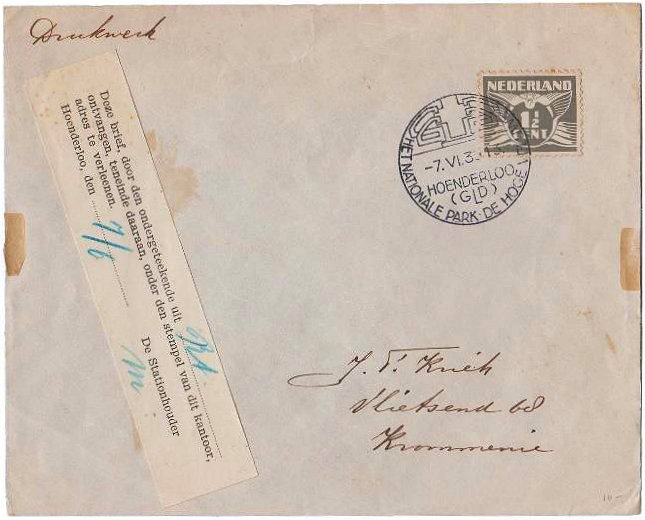
It is a postal label. This was confirmed to me by the discovery of a second letter with the same label.

And now I know what the purpose of this is, thanks to the latest issue of De Postzak ("the mail bag"), the association magazine of Po & Po, the Dutch Association of Collectors of Postal Stationery and Postmarks. I like to share it with you together with some quotes from the article, written by Jos Stroom.
First of all he quotes the source of the text of the label, which is article 482 of the Dutch Postal Regulations of 1928:
Letters received at the address of directors or other postal officials, requesting that they be forwarded with the postmark of their office, shall have the following endorsement on the reverse side before being forwarded, after being stamped:
This letter has been received by the undersigned from ......
with the aim to assign the address of this office.
......, the ...... 19.. The director / station official
In plain English, the complicated official language means no more than that the letter from ... (fill in the city name of the sender here) has been received with the request to forward it to the addressee with the postmark of the office. This addressee could also be the sender himself.
And when I look at the letter again, I see that the cancellation was done with a quite special postmark.
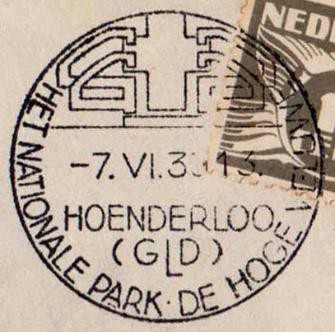
In other words, it has to do with postmark collectors, to whom the PTT gave its cooperation for a while. By the way, not with specially made postmarks, on the contrary, in one of the later service orders it is stated that the normal postmark must be used. But the post office in Hoenderloo happened to use a special postmark:
There the mail that was delivered to the mailboxes on location was stamped with a special postmark. That happened every year from 1939 until 1969, from 1 June until 31 August.
Apparently so many philatelists made requests for this, that special slips (labels) were printed for post office Hoenderloo.
Jos Stroom mentions that the few letters he has are from the early years. My letters are also stamped in 1939 and 1941. It seems special to me to find such a letter with a postmark from the fifties or sixties.
In his article, Jos Stroom also shows a few letters that have been handled by other offices and where, instead of a label, the prescribed text is written by hand.
I was wondering how the sender had achieved this. If he simply put his letter in the mailbox, it would (first) be stamped in the place of the sender. So how does his letter get the intended stamp? In the case described here by going to Hoenderloo in the summer and post his letter there. Or, by enclosing the letter in another letter and sending that to the relevant office with the request to stamp the enclosed letter there. So it is clearly a collector's affair.
Now you might remark "what has this got to do with our collecting theme?" In 1939 the PTT also started with a mobile post office, in Dutch called "Autopostkantoor". This office was used as an extra post office during big events. The TT races in Assen were the first ones in 1939. During the races on 30 June and 1 July the mobile post office was present. People could send mail from the TT home.
Special photo cards of earlier races were provided with the special Autopostkantoor postmark.
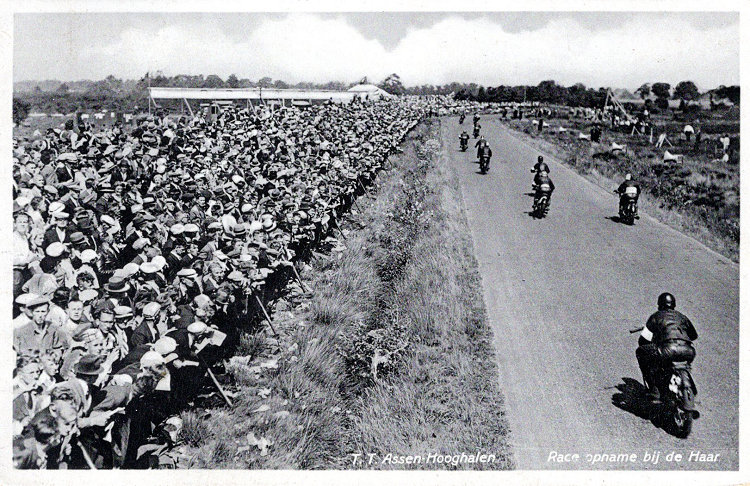
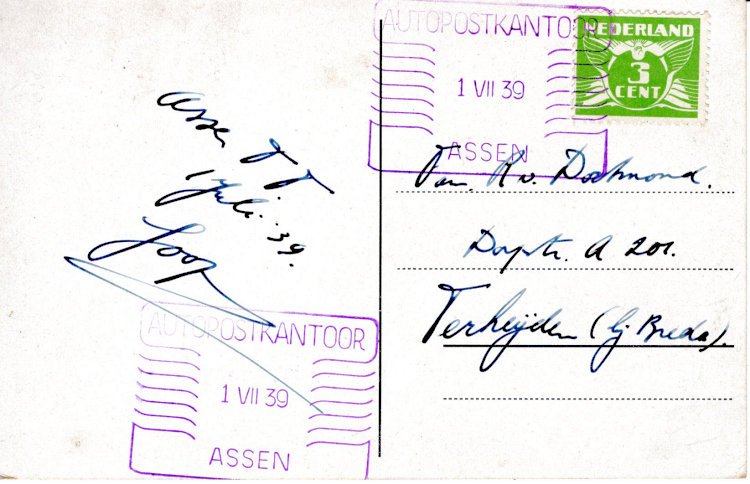
From the date in the postmark it is clear that the races were not always held on the last Saturday in June. July 1st was on a Saturday in 1939.
Handy traders/collectors (cross out what is not wanted) saw opportunities to acquire a nice postmark. They sent a franked envelope to the temporary post office, or went there themselves, to send it with the beautiful Autopostkantoor postmark. Sometimes even abroad!
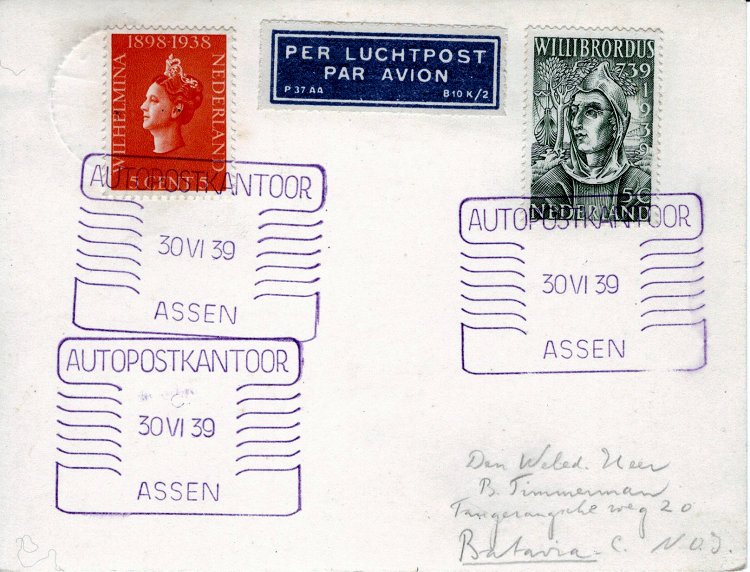
Here Mr H. L. S. Adama, remember the name, sent a letter from Assen to Batavia. That was on the first day the post office was operational: Friday 30 June. Judging by the arrival stamp on the back the letter seems to have arrived in Batavia (Netherlands East Indies) on 6 July.

But Mr Adama was quite active in that period. He was a specialist in the field of Aerophilately, and even a member of the board of the Flying Dutchman. Perhaps he recognised a new area of collecting: mobile post office postmarks.
Remember the beginning of this article. Letters were sent or brought to Hoenderloo, in order to acquire the beautiful postmark. Mr. Adama went one step further. He sent a letter to Hoenderloo and from there it was sent to himself at the mobile post office in Assen.
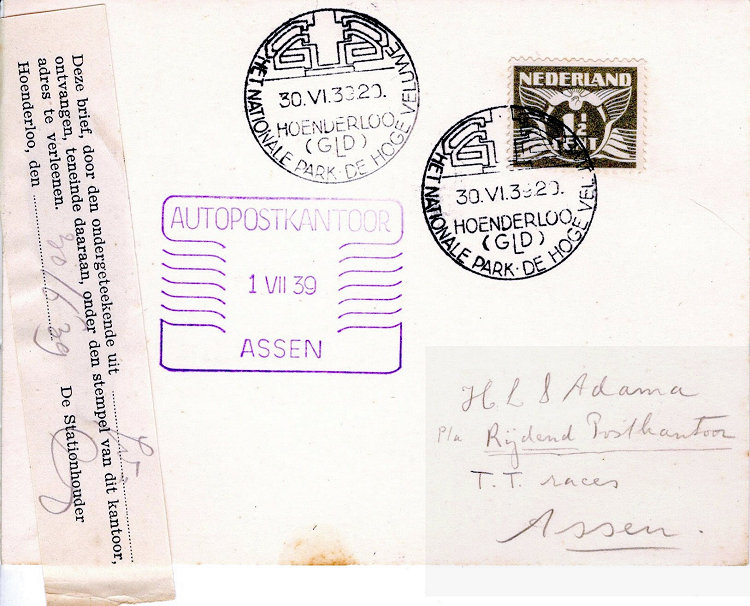
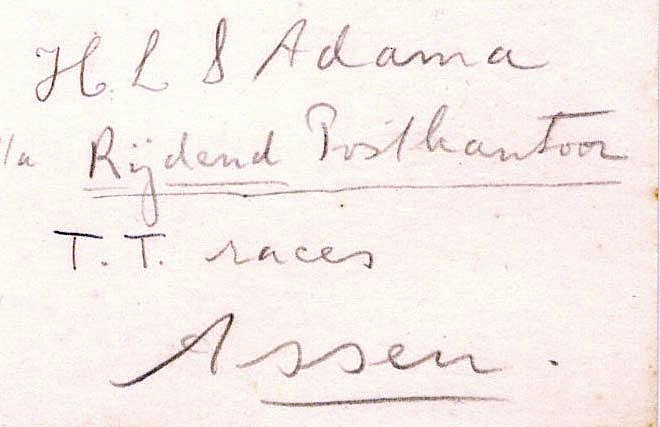
Considering the stamps, it must have been a precision job. The letter is stamped 30 June in Hoenderloo and sent to Assen. There the letter arrived on 1 July judging by the Autopostkantoor postmark.
Mr. Adama collected the letter at the counter there. This way he got two special stamps on one envelope.
Whereas we can assume with Joop's card that it was "really" sent by a visitor, the two later letters are less clear. It is certain that the letter with postmark Hoenderloo is a goodwill towards the postmark collector. The second letter clearly shows that Mr. Adama was aware of the possibility to obtain special stamps, he has also been on the TT both days as proven by the two letters. On Saturday 30 June he sent the letter to Batavia, and on Sunday 1 July he collected the letter from Hoenderloo.
Nico Helling
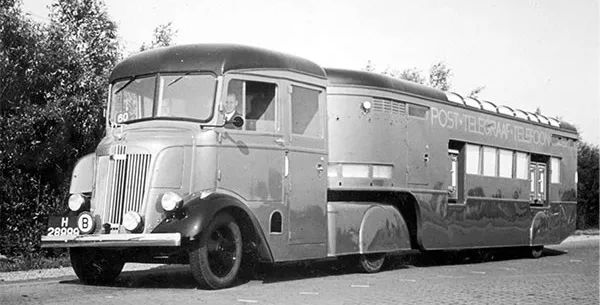
The original mobile post office from 1939
Top - Back to former page - Home |